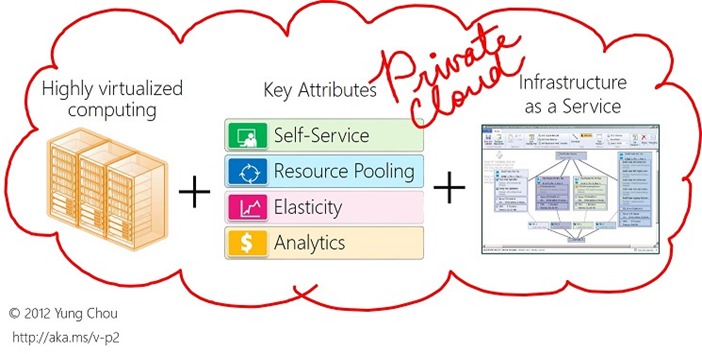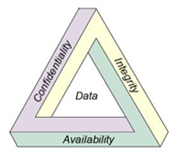A Private Cloud Delivers IT as a Service (Virtualization vs. Private Cloud, Part 2)
| Build your test lab with Boot-to-VHD. Here are the steps. | |
 |
Deploy a VM to cloud and build your lab in Windows Azure with 90-day free trial. Here's how. |
 |
Preping for Microsoft certifications? Join our Windows Server 2012 "Early Experts" Study Group. |
A private cloud delivers business functions as services, while virtualization virtualizes computing resources supporting the private cloud. They are two different concepts, address different issues, and operate at different levels in enterprise IT. A private cloud goes far beyond virtualization and virtualization is not a private cloud. To conclude this two-part series as listed below, here are the specifics regarding a private cloud vs. virtualization.
- Part 1: Cloud Computing Goes Far Beyond Virtualization
- Part 2: A Private Cloud Delivers IT as a Service (this article)
An essential part of a private cloud is virtualization that offers opportunities in reducing infrastructure costs, increasing operational efficiency, and improving deployment flexibility. A server instance deployed with a VM offers many advantages over one deployed with a physical machine. And VMs facilitate the implementations of resource pooling, rapid elasticity, and hence a private cloud. Notice that the benefits of virtualization including lower costs, higher efficiency, flexible deployment, etc. however do not translate themselves directly to "capacity on demand" which is much more and what a private cloud delivers.
Virtualization Is Not Private Cloud

In addition to missing the five essential characteristics as criteria, it is not required to deliver virtualization with SaaS, PaaS, or IaaS. Namely, virtualization is not necessarily presented as a "service" while a private cloud always is. What virtualization offers is to virtualize resources without specifying how the virtualized resources are made available to users. In other words, virtualization introduces a mechanism to facilitate implementations of some, but not all, of the private cloud requirements. To equate virtualization to a private cloud is to mistakenly present part of a solution as the solution itself.
Private Cloud Priorities
The term, cloud, denotes the abilities to exhibit the five essential characteristics with one of the three possible delivery methods of a service as stated in the 5-3-2 Principle of Cloud Computing and NIST SP-800-145. When one claims having a “cloud” solution, we can easily verify it with a few simple questions: Can a user self-serve? How accessible? Is it delivered with (or at least a flavor of) SaaS, PaaS, or IaaS? Is it elastic? Does it have some analytics component?
From a private cloud’s view point, two of the five essential characteristics of cloud computing become optional. They are ubiquitous access and consumption-based chargeback model. This is absolutely not to suggest the two are not applicable. They very much are for any solution qualified with the term, cloud, including a private cloud. There are however legitimate reasons to consider the two differently regarding a private cloud.
Specific to a private cloud, there are however different priorities on the five essential characteristics. One of the five essential characteristics becomes optional in a private cloud setting. Either on premises or hosted by a 3rd party, a private cloud is expected to exhibit self-service, resource pooling, and elasticity of cloud computing. In addition, even if chargeback is not technically or politically realistic in an enterprise setting, analytics must be designed in to provide insight of resource consumption and usage patterns. This is due to self-servicing and elasticity can make a workload very dynamic, and statistical data based on analytics are imperative for planning capacities based on realistic and meaningful data. These concepts are illustrated as below:

Restricted Access
Ubiquitous access in cloud computing implies anytime, anywhere, any device accessibility to a service.  While considering a private cloud, there are scenarios in which general accessibility may not be the intent. The required data confidentiality, integrity, and availability of a private cloud may prevent a service owner from offering a general access. Instead, business requirements may demand, in addition to user credentials, a further restricted access based on a combination of isolation at various layers including a device type, IP address range, port designation, domain membership, constrained delegation, protocol transition, etc. Namely, accessibility of a private cloud should be based on corporate information security policies and not necessarily an architecturally defined requirement. The concept of information security can be best summarized with the so-called C-I-A triad as shown above.
While considering a private cloud, there are scenarios in which general accessibility may not be the intent. The required data confidentiality, integrity, and availability of a private cloud may prevent a service owner from offering a general access. Instead, business requirements may demand, in addition to user credentials, a further restricted access based on a combination of isolation at various layers including a device type, IP address range, port designation, domain membership, constrained delegation, protocol transition, etc. Namely, accessibility of a private cloud should be based on corporate information security policies and not necessarily an architecturally defined requirement. The concept of information security can be best summarized with the so-called C-I-A triad as shown above.
Feasibility of Charging Back
 While transitioning into cloud computing, a realistic approach for enterprise IT is to build a private cloud by first transforming the existing infrastructure components and applications into a target cloud environment. With infrastructure components and an application architecture already put in place, a chargeback model may not always be technically feasible or administratively necessary. To charge back, show back, or sponsor an application without a consumption-based cost morel is up to an organization’s priorities and therefore not necessarily an architectural requirement of a private cloud.
While transitioning into cloud computing, a realistic approach for enterprise IT is to build a private cloud by first transforming the existing infrastructure components and applications into a target cloud environment. With infrastructure components and an application architecture already put in place, a chargeback model may not always be technically feasible or administratively necessary. To charge back, show back, or sponsor an application without a consumption-based cost morel is up to an organization’s priorities and therefore not necessarily an architectural requirement of a private cloud.
The Essence of Charge-Back Model
 Nonetheless, a chargeback mechanism signifies not only the ability to recover costs, but the critical need of designing analytics into a service. By offering self-service and elasticity in a private cloud, the resource utilization can become very dynamic and unpredictable. The ability to monitor, capture, and process utilization data for capacity planning for supporting anytime readiness of a service has become imperative.
Nonetheless, a chargeback mechanism signifies not only the ability to recover costs, but the critical need of designing analytics into a service. By offering self-service and elasticity in a private cloud, the resource utilization can become very dynamic and unpredictable. The ability to monitor, capture, and process utilization data for capacity planning for supporting anytime readiness of a service has become imperative.
System Management Now Even More Critical
There is no question that virtualization is an enabling technology in transforming enterprise IT into a cloud environment. The reality is that virtualization is one component of a private cloud solution. Virtualization is nonetheless unequivocally not a private cloud itself. What a decision maker must recognize is that, for building a private cloud, virtualization, resource pooling, elasticity, and self-service model are to be architected as a whole with consistency, compatibility, and integration. Such that the architecture can fundamentally realize the 5-3-2 Principle of Cloud Computing with a predictable and maximal ROI in the long run. The discovery, deployment, configuration, and management of a target resource from bare medal to runtime are all to be based on a common management platform and implemented with a comprehensive system management solution. Further, a consistent user experience in managing physical, virtualized, as well as cloud resources is critical to warrant a continual and increasing cost reduction of on-going technical support and training.
A Private Cloud Delivers ITaaS
 Above all, a private cloud solution offers a technical architecture to strategically advance go-to-market which has become increasingly critical to the survival of a business facing the unpredictable workloads supported by proliferation of mobile devices and triggered by instant data storms in a highly connected business computing environment. IT professionals must not confuse virtualization with a private cloud. The former is a technically centric and an important piece of private cloud puzzles for virtualizing resources. While the latter focuses on servicing customers with on-demand accessibility and always-on readiness of a target application. The 5-3-2 Principle of Cloud Computing and this two-part series reveal what a private cloud is about. And that is to strategically build a go-to-market vehicle, such that enterprise IT can fulfill business needs and exceed user expectations. With a private cloud, IT can leverage business opportunities generated by market dynamics and offer a user experience with anytime, anywhere, on any device productivity. The ability of acquiring IT capabilities on demand with a private cloud is in essence a reality of "IT as a Service."
Above all, a private cloud solution offers a technical architecture to strategically advance go-to-market which has become increasingly critical to the survival of a business facing the unpredictable workloads supported by proliferation of mobile devices and triggered by instant data storms in a highly connected business computing environment. IT professionals must not confuse virtualization with a private cloud. The former is a technically centric and an important piece of private cloud puzzles for virtualizing resources. While the latter focuses on servicing customers with on-demand accessibility and always-on readiness of a target application. The 5-3-2 Principle of Cloud Computing and this two-part series reveal what a private cloud is about. And that is to strategically build a go-to-market vehicle, such that enterprise IT can fulfill business needs and exceed user expectations. With a private cloud, IT can leverage business opportunities generated by market dynamics and offer a user experience with anytime, anywhere, on any device productivity. The ability of acquiring IT capabilities on demand with a private cloud is in essence a reality of "IT as a Service."
[This article is a cross-posting from https://aka.ms/yc.]
